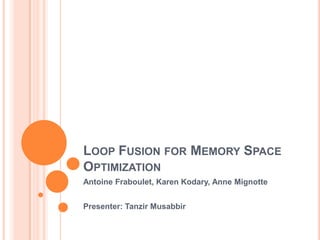
Loop Fusion for Memory Space Optimization
- 1. LOOP FUSION FOR MEMORY SPACE OPTIMIZATION Antoine Fraboulet, Karen Kodary, Anne Mignotte Presenter: Tanzir Musabbir
- 2. Group of people from National Institute for Applied Science, Lyon, France Published in IEEE International Symposium on System Synthesis Year 2001.
- 3. OUTLINE Introduction Problems Some solutions Their Proposed Solution Experiments and Results Conclusion
- 4. INTRODUCTION Multimedia applications are memory intensive application Memory is known to be extremely power consuming Propose a new technique to optimize a behavioral description of multimedia application An optimal algorithm to reduce the use of temporary arrays by loop fusion Polynomial but efficient
- 5. OUTLINE Introduction Problems Some solutions Their Proposed Solution Experiments and Results Conclusion
- 6. PROBLEMS This paper mainly focused on data flow dominated embedded systems It consume memory for multidimensional data storage. More than half of the surface of this type of integrated system is filled by memory. That’s why control over power consumption is necessary.
- 7. OUTLINE Introduction Problems Some Solutions Their Proposed Solution Experiments and Results Conclusion
- 8. SOME SOLUTIONS Memory optimization can be done in several ways: the reduction of the size of the memory and improvement data movement strategies over the memory hierarchy It is useful to make optimization before partitioning As after hardware-software partitioning is done, memory has already been divided It also allows to optimize both types of memories, the one that is included in hardware and the one controlled by software.
- 9. SOME SOLUTIONS In-place-mapping can allow to share memory by overlapping arrays when possible Memory allocation can select memory modules upon several criteria such as size, number of ports. On the opposite, during silicon compilation the physical memory is optimized all along the design chain
- 10. OUTLINE Introduction Problems Some Solutions Their Proposed Solution Experiments and Results Conclusion
- 11. THEIR PROPOSED SOLUTION Proposed a “for” loop transformation to optimize memory size Loop fusion is a program transformation that collapses several loops into one In their proposed solution, memory optimization by loop fusion is obtained by reducing the size of temporary arrays that are typically used to store intermediate results during multimedia processing.
- 12. THEIR PROPOSED SOLUTION Scalar replacement technique can remove an entire array from the applications memory
- 13. THEIR PROPOSED SOLUTION Sometimes dependencies may not allow to remove completely an array by scalar replacement We can apply intra-array storage order optimization in such cases
- 14. THEIR PROPOSED SOLUTION Loop fusion increases the number of statements and accessed arrays within a loop nest. Sometimes loops access more data than can be handled by a cache. That’s why further code transformation are needed to complete the optimization process.
- 15. THEIR PROPOSED SOLUTION They consider a wider class of problems where the loops being considered for fusion need not have conformable headers. Loops with non conformable headers can be fused by using conditional statements to control the execution of operations within the loop nest As both scalar replacement and intra-array storage optimization techniques can handle conditional control flow.
- 16. THEIR PROPOSED SOLUTION They approximate memory size requirement by the maximum size of time overlapping arrays Memory cost function
- 18. THEIR PROPOSED SOLUTION - DFG
- 19. THEIR PROPOSED SOLUTION – REMOVABLE ARRAY DETECTION
- 20. CONFLICTS DETECTIONS AND RESOLUTION Some problems can arise when we consider the removable arrays altogether.
- 21. CONFLICTS DETECTIONS AND RESOLUTION We need to solve all possible conflicts by reducing the set of starred arrays without compromising the global optimality. Identifies all possible conflicts in the graph Solves all these conflicts in a global optimal way
- 23. INTEGER LINEAR PROGRAMMING CONFLICT RESOLUTION ILP formulation for solving dependency cycles conflicts detected in the previous steps We have to decide which array will be taken out of the set of removable arrays It associates a binary variable Xa_i to each starred array a(i) that could be removed If Xa_i = 0 then the array will a_i will be considered for fusion otherwise (Xa_i = 1) the array will cease to be starred.
- 24. INTEGER LINEAR PROGRAMMING CONFLICT RESOLUTION For multi-graphs between two nodes u and v, a new variable X_uv is introduced to resume the arrays on this multi-edges. If X_uv is set to 1 then all associated variables will also be set to 1 and all arrays will be unstarred. Otherwise a variable X_ai can be set to 1 without interfering with other arrays on the multi-edge. The objective of their ILP is to minimize the sum of the size of arrays that have to be removed from the set of all possible starred arrays detected in previous section
- 25. OUTLINE Introduction Problems Some solutions Their Proposed Solution Experiments and Results Conclusion
- 26. EXPERIMENTS AND RESULTS Tested their algorithms using randomly generated graphs. They have chosen to generate graphs that are a lot more complex Generated graphs were ranging from 10 to 30 nodes. Each edge has the probability of 1/3 to be fusion preventing and all weights were randomly chosen
- 28. OUTLINE Introduction Problems Some solutions Their Proposed Solution Experiments and Results Conclusion